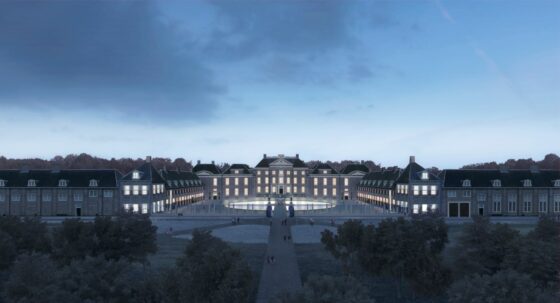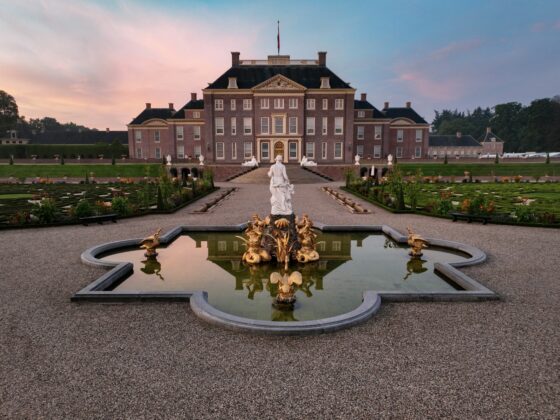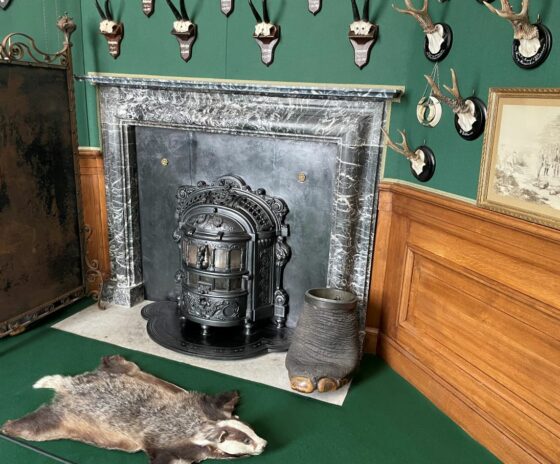Fit for a king: restored Palais het Loo opens its doors


Diana, goddess of the hunt, stands above the door beckoning in visitors. But at the newly restored Palais het Loo – built as a hunting lodge for the 17th century Dutch ruler William of Orange – there are surprises in wait.
This month, the doors will open on a €171 million, five year renovation to create 5,000 m2 of modern museum space.
Unlike previous builds, though, this extension designed by Dikkie Scipio of KAAN Architecten went underground. Underneath what looks to be an untouched, 17th century courtyard, the museum dug a basement 10 metres deep, pumped out 35,000 m3 of water and 1,800 trucks of sand, suspending the historic palace on temporary foundations all the while.
Now, the entrance to Palais van Loo is through a sweeping, grand foyer of marble-like Spanish Bianco Macael stone, with space for temporary exhibits on one side and a whirlwind history tour of the Oranges on the other.
‘This has not been done before, to lift a palace!’ said marketing manager Jacolien van Wezep. ‘It doesn’t look like anything has changed but then you go underground and see this whole modern part. The foundations of the 17th century building that was on four pieces were raised a couple of milimetres.’
Timelapse of the building project
In the historic palace, meanwhile, some 4,300 m2 of asbestos fireproofing added in the 1970s have now been removed, and the palace fully restored to the era of original occupants the Dutch Stadholder William III and his wife Mary – who in 1689 became king and queen of England, Scotland and Ireland.
‘It was constructed before he became king of England,’ explains Michel van Maarseveen, managing director. ‘He asked an institute in France for a plan for the palace. It’s pretty much the same in outline as for instance Versailles, although it is not as elaborate – we call it the Dutch baroque style, inspired by the French baroque but much more sober. After he and Mary became king and queen of England, it was enlarged. It was his favourite palace, actually the only palace he built himself here in Holland.’
Given to the nation and opened to the public from 1984, the palace needed extensive work to remove the asbestos and restore the rooms, but also more space for some 350,000 visitors a year. The gardens, including an orangerie with 200 citrus trees, have also been returned to their full glory, when they were intended to outdazzle those of Protestant William III’s great rival, Catholic Louis XIV of France.

In the new wing, a temporary exhibition, Masterpiece, currently tells the story of the extraordinary renovation. A floor-mounted screen shows a time-lapse video of the process, thanks to photos taken from opposite the main courtyard every day.
In an adjoining room, three artists were invited to create a response to the palace: Linda Niewstad’s artwork Orange Blossom, created from mixed fabrics, a composition inspired by English baroque composer Henry Purcell by Massive Music and a perfume developed by Sebastian Fischenich, chosen by the staff. “It has water, metal, woody notes and the natural smells of orange and blossoms,” said programme maker Marit Berends, adding that since it was the fourth perfume they tried, they are unofficially calling it ‘Paleis No 4’.
On the other side of the new grand foyer is an overview of Dutch monarchy, which started life as the appointed representatives of a foreign king – stadthouders, in Dutch – before becoming a monarchy. Throughout the years, the exhibition shows, there has been criticism and controversy as well as praise. Continuing in the east wing of the palace, the exhibition recounts the lives of these Oranges in terms of major moments – sometimes asking the viewer: ‘where would you rather be?’
Opinions and criticisms
‘We wanted to have a good overview about the monarchy in the Netherlands,’ said van Maarseveen. ‘Whatever a monarch does in his private times, it is always in public: whether you are born, go on holiday in Greece, buy a new boat, die or marry, everything is in the public space and we all have an opinion.
‘For instance, there was a huge debate about the king going to Greece during the Covid times. In the 1980s, when Queen Beatrix was crowned, there were a lot of riots in Amsterdam. People were saying they wanted houses, not monarchy. William V at the end of the 18th century was much criticised by the patriots who wanted more power to the ordinary man. We show those opinions, whether against or in favour of the monarchy – we don’t take sides.’
One exhibit, for instance, raises the ongoing debate about whether or not the current king Willem-Alexander should close the nearby Royal Estate to the public around his typical half day of hunting each year.
A ‘Junior Palace’ for children will open in May, based on a kind of treasure hunt through an imaginary palace, while the historic apartments of the original Paleis het Loo have been fully renovated – including restored wall paintings around the grand staircase and a trompe l’oeil carpet created to blend into the floor.

Hunt
In line with the reality of its hunting past, the museum decided to continue showing objects such as labelled antlers, an elephant trunk lamp shade, bearskin rug and elephant foot coal scuttles, said curator Kristin Duysters. The original height marks on former Queen Juliana are still on a wall. Experts have also restored a basement kitchen where before she became a queen, the English Mary once cooked up jams and sweetmeats, next to her aviary and the entrance to her gardens.
The palace is a living reminder of a historic bond between the Dutch and the British, after William turned up in England together with a printing press to campaign for his Protestant takeover, according to van Maarseveen. ‘The biggest link was in the 17th century when William III united England, Scotland and Ireland together with the Dutch republic,’ he said. ‘Together with Louis XIV, he was the most powerful man in Europe. He combined in his person the two countries. When he passed away, in 1702, the bond was split.’
In the restored palace, William of Orange’s rivalry with the ‘sun king’ Louis XIV lives on in the battle of the highest-spouting fountain. ‘We have here fresh water coming from the surroundings, while in Versailles, they had to pump up the water for the fountain and it really smelt very bad,’ he said. ‘We have a fountain that went up to 13m, while in Versailles the fountain only goes up 11m.’
But light touches aside, the museum hopes its new exhibits and restoration will keep the stories of royalty alive. ‘It is not just about the monarchy but also about the history of the country and how the Dutch operate right now,’ said van Maarseveen. ‘It’s relevant in the world around us as we speak. We invite visitors to make up their own minds.’
Paleis het Loo reopens to the public on April 22
Thank you for donating to DutchNews.nl.
We could not provide the Dutch News service, and keep it free of charge, without the generous support of our readers. Your donations allow us to report on issues you tell us matter, and provide you with a summary of the most important Dutch news each day.
Make a donation